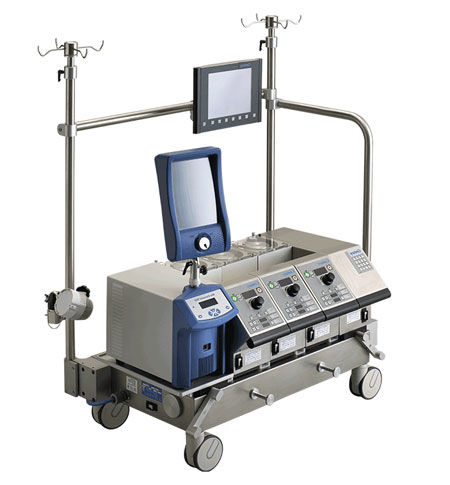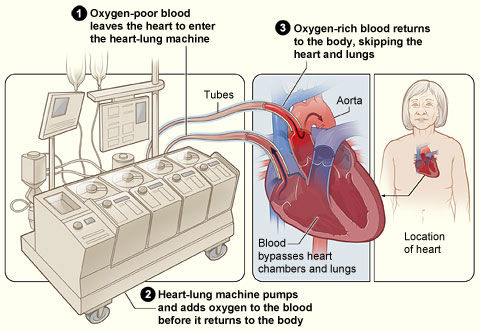Heart Lung Machine: What 5 Facts Should Patients Know?
Written By: Adam Pick, Patient Advocate, Author & Website Founder
Page Last Updated: May 9, 2025
For most patients needing heart valve surgery, a heart-lung machine is typically used during the operation. As you may know, the heart-lung machine enables the surgeon to stop and cool the heart so the valve can be fixed while the heart is not beating.

A Quick History of the Heart-Lung Machine
In the past, I’ve shared a little bit about heart-lung machines. That said, I thought you might like to learn more about the history and the development of this very interesting device.
- The first prototype of the heart-lung machine was constructed all the way back in 1885 by an Austrian-German Physiologist by the name of Maximillian von Frey.
- The first working heart-lung machine was tested during experiments on canines in the 1920s by Soviet scientist, Sergei Brukhonenko.
- The first successful open heart procedure – on a human – using a heart-lung machine was performed on May 6, 1953 by John Gibbon at Thomas Jefferson University Hospital in Philadelphia. That operation was a repair of an atrial septal defect.
The heart-lung machine goes by a couple different names including “cardiopulmonary bypass” and the “pump”.
How Does the Heart-Lung Machine Work?
Over the years, I’ve been fortunate to observe many operations that use a heart-lung machine.
Needless to say, it’s amazing to see the surgeon and the medical team leverage this device throughout a heart valve operation. So you know, the person responsible for the heart-lung machine is known as the “perfusionist”. He or she is responsible for the management of the patient’s circulatory and respiratory activity during a procedure.
To help you learn more about the heart-lung machine, I thought you might like to see this video that I just found. In the video, Dr. Max Feinstein discusses the use of the heart-lung machine.
If you’re curious to see how the heart-lung machine works in 3 steps, I thought you might also like to see this step-by-step diagram.

Do All Valve Procedures Use the Heart-Lung Machine?
So you know… Not all heart valve procedures require a heart-lung machine.
Today, there are several transcatheter procedures (TAVR, MitraClip) that are commercially available, or in clinical trials, that do not use a heart-lung machine. Please note, however, these procedures are currently reserved for patients who are at intermediate risk, high risk or inoperable for surgery.
The fact that the heart-lung machine is not used in catheter-based procedures is often referenced as a potential, therapeutic benefit for the patient. As you may know, there are some potential complications that may occur from the use of bypass including post-perfusion syndrome, more commonly referred to as “pumphead”.
That being said, there are potential complications with most procedures. Fyi, my personal experience with the heart-lung machine resulted in no complications. And, many, many, many, many patients in this community had successful open heart procedures that used the heart-lung machine… They’re doing fine too!
Related Links:
- Ask Dr. Chikwe: Stopping The Heart During Cardiac Surgery
- Restarting The Heart After Cardiac Surgery with Dr. Gerdisch
I hope this helped you learn more about the heart-lung machine!
Keep on tickin!
Adam
|
rubart says on September 12th, 2017 at 7:45 pm |
|
I had open heart surgery in August 2015 to fix two valves: repair of my mitral valve and replacement of my aortic valve. My only anxiety was the heart-lung machine. I do a lot of “brain” work, and I was fearful that I’d come out of my surgery with less brain power than I had going in. Didn’t happen. I came out fine, and I think that’s true of the vast majority too. You may be a little “foggy” immediately after, but that could be from any number of things. The heart-lung machine is a miracle, and I’m very grateful for it. |
 |
|
Bryan Bohay says on September 12th, 2017 at 10:09 pm |
|
I have been on it three times now all for mitral valve redo surgery first in 2000 2001 2012 I don’t think there have been any deficits ,but if there were how would the patient be the one to judge?There are so many things that happen to the system when heart surgery is performed that it would be difficult to pinpoint which one causes which symptom. |
 |
|
Joan Davenport says on September 13th, 2017 at 8:14 am |
|
alot probably depends on the skill of the perfusionist…………..I had open heart surgery to replace my aortic valve in 2012 and did not have any reprecussions from being on “THE MACHINE”…………… |
 |
|
rubart says on September 13th, 2017 at 8:42 am |
|
That’s why it’s SO important to not just research your surgeon, but research your hospital. My hospital has an excellent reputation, and if it didn’t, I wouldn’t have gone with my surgeon, no matter how much I wanted him. |
 |
|
rubart says on September 13th, 2017 at 8:43 am |
|
That’s why it’s VERY important to not just research your surgeon, but research your hospital. My hospital has an excellent reputation, and if it didn’t, I wouldn’t have gone with my surgeon, no matter how much I wanted him. |
 |
|
Bryan Bohay says on September 13th, 2017 at 10:20 pm |
|
When I had my first surgery it was an emergency not an elective surgery I was unconscious due to an embolic stroke in the occipital lobe.I was transferred from a normal hospital to the university of Ottawa heart institute.The founder of the heart institute consulted with my family and they assigned a young surgeon Fraser Rubens to do my surgery.When I first awoke after the surgery I thought I had been in a car wreck it took them a while to convince me otherwise (but in my defense I was not conscious when I was transferred ) The first redo was caused by a second staphylococcus infection under my thumb nail from a wood sliver at work.I of course got the same surgeon as he was familiar with my case.The third redo was caused by a strep infection acquired during hernia surgery at another hospital ,got my usual surgeon for the heart stuff.The last hospital stay was from august 3 until October 9 2012 a lot of that was unconscious.Now were both a little greyer.Did not feel any cognitive impairment from the last two surgeries like I did for the first. |
 |
|
Cesare DelVaglio says on September 14th, 2017 at 8:25 am |
|
Well done. June of 2010 I was in a scheduled quintuple bypass with aorta valve replacement for 6 hours. Don’t know how long I was on the h-l machine, but I was up the next day walking, had two units of blood introduced through the neck line and was out of hospital day 5. Had no complications. |
 |
|
rubart says on September 14th, 2017 at 12:33 pm |
|
Following up on my comment below re: the hospital is important too: the AARP Bulletin has a terrific current (Sept. 2017) issue “Your Critical Health Decisions.” In addition to its tips on finding the best surgeon, there’s an article of tips on how to “Choose the Best Hospital.” As the article says, “You need a proven team to support your surgeon.” If you don’t receive the Bulletin, you can google it online, or check your library. It’s well worth reading, and will help you make sure your heart-lung machine operator (etc.) is likely one of the best. |
 |
|
Lisa Ferguson says on October 16th, 2017 at 3:27 am |
|
This was a big concern for me before my mitral valve surgery. I was very worried about what might happen to my brain function and tried to learn how much truth there was to “pumphead”. I was happy to find no conclusive data one way or the other and believe my brain is “normal” (well, at least functioning) after surgery! I will say that I’m grateful for technology improvements. The pump machines of the past were really rough on the blood cells. I think the history of pumphead might have been more true years ago compared to now. |
 |
|
Qasim Al Saigh says on May 21st, 2018 at 7:37 pm |
|
After TGA operation heart is not pumping properly for my baby so they kept her on this machine. |
 |












